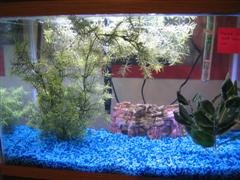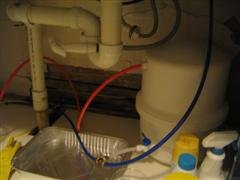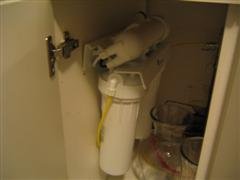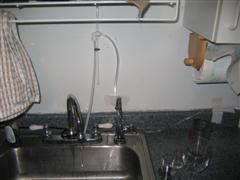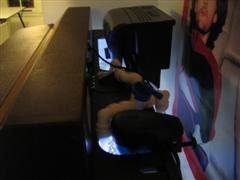perle
Aquarium Advice Apprentice
Hi all,
I have constructed a devilish mechanism to automatically filter/change the water in my new 20 gallon (little small but all I have room for right now) tank. Basically I am sick of having to deal with awful city water so I overengineered this device.
So now I have a reverse osmosis filter (consumer grade, from home depot) installed under my kitchen sink, and have tapped the output line and can run it to the fishtank where it trickles in by the filter. This way the fish and the people both get nice water, and the low output is fine since I have a small tank. I plan to cycle 5 gallons a day.
Incidentally the whole filter project has cost me less than $200.
Filter: $160 - $40 rebate
Tubes, fittings, etc.: $30
New high-powered heater: $20
R/O Right aquarium replenishment minerals: $16 for 500g
----
$186
Not so bad really and it will have the pleasant effect of cooling the tank somewhat in the summer, too.
The outtake from the tank works by the power of gravity, the tube makes a loop over the sink and at the tip of the loop, which equals the level of water I want in the tank, there is an airhole. As long as the tube never empties of water it will work fine. At least that is my plan.
Update: my plan totally worked!
Ok, two questions:
1. My incoming tap is hardness 120-140ish ppm. My output from the RO unit is hardness 50ppm. I was disappointed that it was still that high, I was hoping for more like 5ppm. Will this diminish over time? Is this normal? I am going to call GE but I thought maybe you guys could help too. Admittedly my dip-strip test kit is not precise.
2. Also, where should I position the intake/outtake within the tank? I was thinking I would put the intake by the filter I guess to encourage even distribution, and the outtake down under the gravel in the diagonally opposite corner. Maybe you have a better idea?
I realize that having the outtake low in the tank leaves a possibility of draining the tank entirely if the opposite end somehow gets ripped down, so I might not do that after all.
Anyway right now there is one zebra danio in there to help it cycle. We will see.
Everyone let me know what you think.
~perle
------------------
Bring me some luck, little junebug...
I have constructed a devilish mechanism to automatically filter/change the water in my new 20 gallon (little small but all I have room for right now) tank. Basically I am sick of having to deal with awful city water so I overengineered this device.
So now I have a reverse osmosis filter (consumer grade, from home depot) installed under my kitchen sink, and have tapped the output line and can run it to the fishtank where it trickles in by the filter. This way the fish and the people both get nice water, and the low output is fine since I have a small tank. I plan to cycle 5 gallons a day.
Incidentally the whole filter project has cost me less than $200.
Filter: $160 - $40 rebate
Tubes, fittings, etc.: $30
New high-powered heater: $20
R/O Right aquarium replenishment minerals: $16 for 500g
----
$186
Not so bad really and it will have the pleasant effect of cooling the tank somewhat in the summer, too.
The outtake from the tank works by the power of gravity, the tube makes a loop over the sink and at the tip of the loop, which equals the level of water I want in the tank, there is an airhole. As long as the tube never empties of water it will work fine. At least that is my plan.
Update: my plan totally worked!
Ok, two questions:
1. My incoming tap is hardness 120-140ish ppm. My output from the RO unit is hardness 50ppm. I was disappointed that it was still that high, I was hoping for more like 5ppm. Will this diminish over time? Is this normal? I am going to call GE but I thought maybe you guys could help too. Admittedly my dip-strip test kit is not precise.
2. Also, where should I position the intake/outtake within the tank? I was thinking I would put the intake by the filter I guess to encourage even distribution, and the outtake down under the gravel in the diagonally opposite corner. Maybe you have a better idea?
I realize that having the outtake low in the tank leaves a possibility of draining the tank entirely if the opposite end somehow gets ripped down, so I might not do that after all.
Anyway right now there is one zebra danio in there to help it cycle. We will see.
Everyone let me know what you think.
~perle
------------------
Bring me some luck, little junebug...

